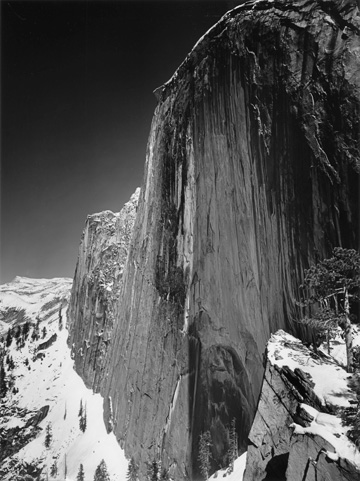JOHN SEXTON PHOTOGRAPHY NEWSLETTER
April 10, 2012

Monolith, The Face of Half Dome
Yosemite National Park, California
Photography by
Ansel Adams
April 10, 1927
©2012 The Ansel Adams Publishing Rights Trust
Exactly eighty-five years ago today a group of five
close friends left Happy Isles in Yosemite Valley on an eventful
climbing and photography journey. The group consisted of Ansel Adams
and his fiancé Virginia Best, along with friends Charlie
Michael, Arnold Williams, and Cedric Wright. I wonder if any of those
individuals realized the significance that day would have on the
vision and eventual career of the young photographer Ansel Adams when
they began their trip early on that chilly spring morning.
Ansel was carrying his 6-1/2 x 8-1/2-inch Korona view camera,
two lenses, two filters, his wooden tripod, and twelve heavy Wratten
panchromatic glass plates. Their destination was an outcrop nearly
3,500 feet above the Valley floor known as the Diving Board. The
group started up LeConte Gully under the north face of Grizzly Peak.
Even today there is no trail as such. Ansel had chosen to carry glass
plates for his view camera because that was the only way he could
access the relatively recent introduction of panchromatic emulsions
for his 6-1/2 x 8-1/2 camera. At that point films were available in
that format, but they were only available with orthochromatic
sensitivity. I find it interesting that the youthful and enthusiastic
Ansel Adams was working with the latest photographic technology at
the time. Little did he know that his recently acquired filters and
this new type of emulsion technology would give him the tools to
change his photographic vision forever.
The group
arrived at their destination just before noon while the face of Half
Dome was still in shade. According to Ansel, “The sun moved
onto the face in early afternoon.” At that point Ansel had just
two glass plates remaining - all of the others had already been
exposed. He set up his view camera with his Tessar lens and exposed
the first glass plate, using a Wratten No. 8 (K2) yellow filter. This
produced a fairly literal interpretation of the scene with a middle
gray sky. For the first time ever Ansel realized that this was not
going to be the equivalent of what he saw, and even more importantly
what he felt, the massive face of Half Dome. Ansel replaced the
yellow filter with his only other filter, a deep red Wratten No.29
(F) filter that dramatically darkened the sky and created an image of
simple austere abstract beauty. Ansel wrote about this experience in
his Autobiography: “I felt I had accomplished something, but
did not realize its significance until I developed the plate that
evening. I had achieved my first true visualization!” In other
words, he imagined the final print in his mind’s eye and then
took the necessary steps to achieve that image.
The
result is one of my favorite Ansel Adams photographs - Monolith,
The Face of Half Dome. This image along with two others made
earlier that day was included in his first portfolio: Parmelian
Prints of the High Sierra. So, not only did he make an image
that remained important to Ansel throughout his entire life, on that
same day he made three meaningful photographs starting with only
twelve glass plates!
Ansel himself was deeply attached
to the Monolith image and said in his book Examples,
“I can still recall the excitement of seeing the visualization
“come true” when I removed the plate from the fixing bath
for examination. The desired values were all there in their beautiful
negative interpretation. This was one of the most exciting moments of
my photographic career.”
Though Ansel was asked
countless times what his favorite photograph was, he never answered
the question directly. In the years that I knew and worked with him,
his repeated reply was a simple statement that he borrowed from his
long-time friend Imogen Cunningham, (always giving her credit):
“The one I’m going to make tomorrow.” I believe
that April 10, 1927 was a benchmark for Ansel and it led to many
successful images, as the tomorrows unfolded into a rich and
productive photographic career.
I am certain that none
of those intrepid adventurers could have imagined the impact that one
of the images made that day would have on the world of photography,
art, and the general public. Monolith, Ansel’s first
visualization, is as effective and contemporary today as it was when
Ansel made the image eighty-five years ago.
–John
Sexton
April 10, 2012
If you are receiving this message in error, please accept our apologies. If you prefer not to receive future email updates from us, just send a quick note with your email address to: remove@johnsexton.com and we'll take care of it. We respect your privacy, and do not disclose email information to outside mailers.
Copyright © 2012
John
Sexton. All rights reserved.
|

